April 2000 (Part 3)
SELECTION OF QUESTIONS AND ANSWERS
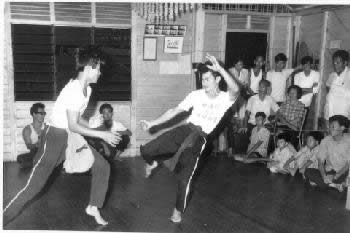
An invaluable old picture taken about 30 years ago showing Poh Luk and Ah Kai (both are Sifu Wong's senior classmates) engaged in an annual grand free sparring competition in Sifu Ho Fatt Nam's Shaolin school.
Question 1
Explain to me please your relation with the monk of Shaolin monastery of whom you are the successor of the 4th generation.
— Roberto, Italy
Answer
About 150 years ago the Qing Dynasty army attacked and burned the southern Shaolin Monastery. Only top Shaolin masters escaped. One of these was the monk Jiang Nan. He escaped to the south, with the Qing army trailing him. He had one mission in life, which was to pass on the Shaolin arts to one successor.
After about 50 years of searching, he found Yang Fatt Khun at the border between Thailand and Malaysia. Yang who was an expert at the phoenix-fist was then in his twenties. He was a travelling medicine-man who demonstrated kungfu to attract customers to his mobile road-side stall.
The Venerable Jiang Nan observed Yang's kungfu demonstration every night. On the seventh night, after the crowd had dispersed the Venerable Jiang Nan approached Yang and told him that despite the loud applaud he had received from the crowd, his was not real kungfu but “flowery fists and embroidery kicks”, a figurative term meaning that his kungfu was not effective for real fighting, and was meant only for demonstration. Yang was surprised because he had often used his kungfu effectively to ward off Muai Thai fighters who frequently troubled him in his travelling.
The monk told him that he needed not accept the opinion but to test it in a friendly sparring. “Kungfu is meant for fighting, and not meant for demonstration”, the Shaolin monk told the travelling medicine-man. This saying has come down to our school, Shaolin Wahnam, as a basic tenet. To his utter surprise, Yang found that this eighty-year old monk, while never hurting him, played him about like a child. Yang Fatt Khun then begged the Venerable Jiang Nan to teach him kungfu.
When Yang Fatt Khun was in his seventies he accepted a young man called Ho Fatt Nam, who was already well trained in seven styles of martial arts and who earned his living as a professional Muai Thai fighter. At first Yang rejected Ho's persistent entreaties to be a student. When he ran out of excuses to reject Ho, Yang told Ho that he was no longer teaching kungfu (which was true if it was taken to mean teaching kungfu publicly).
One night with the help of Yang's senior student, Ho managed to “sneak” into their secret training hall and caught Yang teaching kungfu. Ho came prepared with the traditional gifts to offer a master. He prostrated before Yang and offered the gifts. Placing the gifts on the altar dedicated to past Shaolin masters, Yang remarked, “This is heaven's will” (that I should accept him as my student).
Every year Yang Fatt Khun conducted a grand sparring competition amongst his students to choose the top ten disciples, as was the tradition in the southern Shaolin Monastery in the past. From an unplaced position, Ho Fatt Nam gradually rose over the years to the third position. In fact his name, which was given by his teacher, is an indication of his third position.
Yang Fatt Khun named his four top disciples Fatt Tung, Fatt Seai, Fatt Nam, and Fatt Pak, which means Spiritual Teaching of the East, West, South and North. When Yang Fatt Khun announced his official retirement, he named Ho Fatt Nam as his successor — as Fatt Tung was already in his eighties, and Fatt Seai had gone back to China.
Like my master himself in his own time, I was one of Sifu Ho Fatt Nam's last students. Earlier I learned from Sifu Lai Chin Wah, who was better known as Uncle Righteousness, and from Sifu Chee Kim Thong, respectively the patriarch of Hoong Ka Kungfu and of Wuzu Kungfu. Later I learn from Sifu Choe Hoong Choy, the patriarch of Choe Family Wing Choon Kungfu.
It was no co-incidence that I learned from the patriarchs of the respective styles. Being an idealist, I wanted to learn from the best. Except for Uncle Righteousness from whom I learned through sheer luck (or was it?), I spent much time and effort searching for masters. My school, Shaolin Wahnam, is named after my two masters, Sifu Lai Chin Wah and Sifu Ho Fatt Nam, as a token of appreciation for their kindness and generosity in teaching such wonderful Shaolin arts.
Question 2
Could you please give more information about the many weapons of Shaolin kung fu?
— Darren, UK
Answer
Shaolin Kungfu, especially Northern Shaolin, is exceeding rich in weapons. In the past weapon training was more important than unarmed training. This was logical because, except the unrealistic hero in movie films, who would not use a weapon in combat when weapons could be carried about freely. Since the Yuan or Mongolian Dynasty, however, when weapons were outlawed, unarmed fighting became more prominent.
Shaolin weapons were traditionally divided into two main categories: long and short. Long weapons are those with the weapon head attached to a long staff, such as the spear, the battle axe, the Big Knife, the Big Trident, and the snake-lance. Short weapons are held by a short handle in one hand, such as the knife, the sword, the rod, the soft whip, and the dagger.
The kungfu saying, “one inch longer, one inch stronger; one inch shorter, one inch trickier”, summarizes the comparative advantage of the long and the short weapons. If you hold a long spear, for example, you can more easily keep your opponent at bay. If you hold a dagger, especially when you have succeeded in getting close to your opponent, you have a greater range of techniques.
The most important, as well as most representative of both Northern and Southern Shaolin weapons, is the staff. It looks simple but all the important techniques of long weapons as well as most of the techniques of short weapons are found in it! The staff is therefore considered as both a long as well as a short weapon.
Question 3
Which weapons are common to certain styles and which weapons you practice/teach.
Answer
The most popular weapons common to most styles are the knife (or broadsword), the sword, the staff and the spear. Hence, these four are the only weapons found in modern wushu.
Some styles are well known for particular weapons. Some examples are the single knife of Hoong Ka, the butterfly knives of Wing Choon, the big-knife of Choy-Li-Fatt, the three-section staff of Praying Mantis, and the tiger-hooks of Eagle Claw Kungfu. In the internal styles, Taijiquan is famous for the sword, Baguazhang for the single knife, and Xingyi for the spear.
I used to practise and teach a great variety of weapons, including more fanciful ones like the soft whip, the copper hammer, the snake-lance and the crescent-moon spade. But in my more matured years, I have discarded much of teaching weapons and focused on unarmed combat, realizing that although practising with kungfu weapons still bring present-day benefits, in realistic terms it is more for demonstration.
Question 4
Also could you demonstrate an application of the three section staff and double tiger hooks
Answer
I am not trained in the three-section staff or the double tiger-hooks, and thus would not be able to give a good demonstration. I would instead demonstrate a wrong, but common, application of two weapons I know quite well — the staff and the sword — and how they should be used.
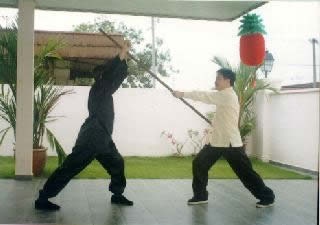
A wrong use of the staff, which is often seen in demonstration. Blocking a downward strike of another staff in this way leaves the exponent disadvantageously exposed.
Question 5
I went to a Shaolin kungfu school where a Shaolin monk taught. I hoped it would be true kungfu but after talking to the students and seeing the training it turned out to be wushu. I was puzzled when I saw the Shaolin monk. He had hair on his head. Are Shaolin monks allowed to have hair on their head?
— Suis
Answer
Traditional Shaolin Kungfu is no longer taught even in the Shaolin Monastery of China today. What is taught there, or more correctly in the numerous schools around the monastery, is modern wushu. This is the same modern wushu taught anywhere else in China or anywhere else in the world.
True Buddhist monks, from the Shaolin Monastery or from anywhere, do not have hair on their head. Shaving the head is an essential rite when a person is first accepted on probation into the Buddhist monkhood, and keeping the head bald is an essential monastic rule. The “monk” you referred to, I was told, left monkhood, settled down in a foreign country, married and now lives a layman's life.
Question 6
I couldn't find any other Shaolin kungfu school so I've joined a Wing Chun school. I have been practicing it for 7 months and now I have some doubts. Our training is divided in three sections. We do a warming up of 30 minutes, which consists of running, pushups, abdominal exercises, stretching and other exercises.
Answer
Different teachers may teach differently, but in my opinion there is no necessity for warming up in traditional kungfu training! This is in line with my own experience in learning from my four kungfu masters, all of whom were patriarchs in their respective styles, and is also in line with kungfu masters of the past. After all, a kungfu exponent is trained to respond instantly and efficiously to any sudden attack, without any moment to warm up first.
Running, pushups and abdominal exercises are not normal kungfu training methods, although they may sometimes be used as supplementary exercises. Stretching is an important kungfu training method.
Question 7
Then we train the form and do one-step attack/defence exercises for about 1 hour.
Answer
This is a usual kungfu procedure, but the one-step attack/defence exercises should lead to more advanced exercises for combat.
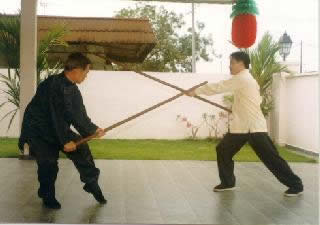
Here Sifu Wong demonstrates a right application of the staff against a downward strike of another staff. As Goh strikes down with his staff, Sifu Wong shifts to his right side and simultanteously strikes Goh's front wrist with his staff
Question 8
Finally we spar using gloves for about 30 minutes.
Answer
Not a single kungfu master in the past used gloves for sparring. Indeed I believe that any instructor asking his students to use gloves, himself has had no experience of genuine kungfu sparring. Using gloves to spar, especially without methodical preparation, almost always results in the students resorting to boxing or kick-boxing techniques.
Question 9
I just hate sparring. I feel like a living punch bag. When I spar with senior students I am helpless; I can hardly touch them.
Answer
Your case, which is also the case of the majority of kungfu students today, is unfortunate. Sparring is an essential, and actually a lively and enjoyable, part of kungfu training. It is often in sparring, pre-arranged or free, that the beauty and efficiency of kungfu is brought to life.
Something is basically wrong if anyone becomes a living punch bag in sparring, in which case it ceases to be sparring, it has become a free exchange of kicks and blows. In traditional kungfu sparring, including free sparring, no one should be hurt. In the past, even free sparring was carried out with weapons; hurting one another was out of the question.
Question 10
Our teacher tells us to try to use the techniques that we have learned and to attack. But till now it is merely exchanging blows and doing chain punches. I try to be relaxed and to use the techniques and to stay in my stance but everything just goes too fast.
Answer
The teacher did not have proper training in kungfu sparring when he was a student, otherwise he would not merely ask his students to try to use their techniques, he would instead actually and systematically teach them how to use the techniques.
Let us take an analogy. Suppose you are a properly trained swimming instructor. You would first teach your students the appropriate swimming techniques. Next you would have them practise the techniques systematically, first with full control, then as they progress you would gradually release the control.
Only when they are competent you would allow them to swim, but still under close supervision and relevant correction whenever they make mistakes. You do not simply throw your students into water and ask them to try to swim.Question 11
Sometimes I try to defend only but I can't deflect anything, I'm too slow. I have been sparring since the first lesson.
Answer
This is because you have not been properly trained. Asking a kungfu student to free spar in his first lesson is like throwing a beginner into deep water in his first swimming lesson and asking him to try to swim.
There are many types of sparring, and I reckon that here you are referring to free sparring. In traditional kungfu training, free sparring comes at the end of combat training, and not at the start.
Free sparring is not meant to teach fighting, as many modern instructors mistakenly think; it is meant to test and confirm that the students can fight. And they can fight effectively only if they have been systematically trained to do so.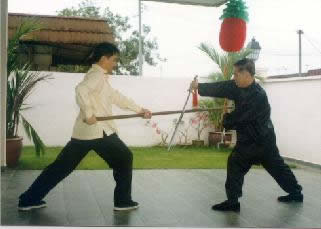
A wrong application of the sword not uncommonly seen in demonstration. Blocking a horizontal sweep of a staff this way with a sword would result in the sword broken in two or more pieces. How then should one defend against a horizontally sweeping staff? An example is givein in the picture below.
Question 12
Most other students seem to enjoy the sparring. I have talked to senior students about it. They say it is normal to get a lot of hits in the beginning, sparring is to develop stamina, sparring is a way to see if the techniques work. You must learn to accept hits and learn how to really hit instead of merely touching a person.
Answer
It is not normal to be hit, not even once. That is the fundamental purpose of combat training. Should this happen in the past, especially when sparring with weapons, the students would have been killed many times over. If in your sparring practice you are hit, it is accidental, not normal, and it indicates that you have failed in your purpose.
Sparring may develop stamina, but that is not its main purpose. There are other and better methods to develop stamina.
Sparring is not a way to see if the techniques work. In the first place, there is no questions about whether the techniques work. If there is any doubt, that technique should be discarded. Only techniques that have proven to work well are selected and practised, and in any particular combat situation the best one amongst the many available proven techniques is applied. In combat there is no room for chance; the combatant has to be 100% sure.
If in real combat or free sparring, a combatant is hit, it is not because his chosen technique cannot work, but because he lacks the appropriate skills to use the technique effectively. The fact that he chose the technique means not only it can work but it is the best for that particular situation. If he does not know which technique to use, then he should not be sparring in the first place. He is simply not prepared; he should go back to earlier stages of pre-arranged sparring.
Accepting hits and really hitting others may be normal in a brawl, but certainly not normal in traditional kungfu sparring. A kungfu exponent is expected to effectively defend against all hits, and if during sparring practice his partner could not defend against his attacks, he should merely touch his partner and not actually hitting.
Even in a real fight, he should avoid hurting an opponent unnecessarily. This is known in kungfu culture as “dim tou wai chi” (in Cantonese). It means in sparring or a real fight, you merely touch your partner or opponent, not really hurt him.
In the past when a master touched another master in a match, the latter would withdraw and gracefully acknowledge defeat. Sometimes he might kneel down and prostrate, and thanked the victorious master for sparring his life — in Cantonese it would sound something like: "thor cheah si fu sau ha lau cheng", which means "Thank you, master, for showing mercy under your hands." This is traditional kungfu culture. Continuing to brutally strike a helpless opponent, and proudly demonstrating to a maddening crowd how merciless he is, is a culture of barbarians.
There was no need for a master to strike hard to demonstrate his force. It was common knowledge that every master would have trained to be so powerful that he could kill or maim with just one strike. Kungfu in the past mainly involved force training, not learning flowery movements for demonstration as is the norm today.
That one touch was not connected randomly, it always aimed at a vital spot. If a forceful strike on a vital spot could not put an opponent out of action, it would at least daze him momentarily, which would be sufficient for the master to follow up instantly and from close quarters a second and a third strike on the same vital spot.
Question 13
I know my sparring skills will improve if I continue doing it
Answer
The way you have been practising your haphazard sparring not only will not improve your kungfu skills, but it is actually detrimental to your development. You are actually conditioning yourself to take unnecessary punishment which may lead to serious injury, and learning to be insensitive, brutal and aggressive which is bad for your psyche.
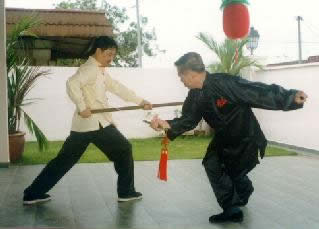
Here Sifu Wong demonstrates a right application of the sword against a sweeping staff. Following the sweeping momentum of the sweep, Sifu Wong moves to his left side and aims his sword onto the right side of the attacker.
Question 14
My teacher says our sparring is very light compared to other martial arts like kickboxing. This way of training feels like the hard way to learn self-defence. I have read your book “The Art of Shaolin Kung Fu” and I think the Shaolin training methods that you describe are a lot more advanced.
Answer
Your teacher has confused brawling with sparring. Kungfu sparring is elegant and safe, but can be very destructive if needed be — more destructive than other martial arts, including kickboxing. Though it is far from pleasant, an able-bodied adult may stand a few kicks from a kickboxer, but he would not last one strike to his eyes or groin from a kungfu exponent.
There is no self-defence in the way of training you have described. It is merely a matter of enduring your partner's strikes while striking hard at your partner at the same time. I do not consider it the “hard” way, in the sense that though the training is tough it brings benefits eventually. I consider it silly; I really cannot think of any reasons why one should subject himself to such punishment, and with no benefits in sight. If he wants to let off stream, he might do kendo; if he wants to be a fierce fighter, he might do Muai Thai Boxing.
Question 15
When I go home after training I feel frustrated. I can't stop thinking what I've done wrong and how to improve my fighting.
Answer
You haven't done anything wrong in your training; it is the training that is wrong. Hence, you got the results the training gave because you carried out your training correctly. Obviously what you need is to change to another type of training which enables you to be combat efficient without having to suffer injuries, and to be calm and fresh instead of being tensed and tired. All genuine kungfu training gives such results — in practical terms, not just in writing.
Question 16
When I feel frustrated I read your webpages or books. They give me inspiration to continue my practise. But after the last training my head ached and it seemed like a sign to quit.
Answer
I am glad you have derived inspiration from my books and webpages. I wish to stress that what I have written in my books and webpages are true, and is written from direct experience. Someone practising the ways I have described will get the results as promised. You can verify this by reading the Comments my students have written, and although other people may regard such experiences as exceptional, they are actually typical of what my students have. In other words, almost everyone who learned from me have had similar experiences.
But you have to learn directly from me. It is difficult to have similar experiences by learning from my books, otherwise you too would have those wonderful results. It is not that I have kept some secrets from my books. In fact one would get much more information from my books than from learning personally from me. The reason is that those wonderful results are obtained from developing skills, and not just from gathering knowledge, and while knowledge can be gathered from books, skills need to be acquired from a master.
Question 17
For the past few months I am thinking of quitting Wing Chun. I know I will get better when I continue training but I don't know if it's worth it any more. Quitting feels like a personal defeat and I think the best of Wing Chun has yet to come. Is it too early to quit? Sifu, could you please give me some advice.
Answer
Often it is not what you learn, but how you learn it that is more important. If you learn Wing Chun the way it was taught by traditional masters, you would have good results. But the ways you described in your training are not the ways the traditional masters taught it. If you continue hurting yourself in your training, physically as well as psychicly, the worst, not the best, has yet to come.
In such a situation, quitting is certainly not a personally defeat. On the contrary, it represents a realization that you have been on a wrong path, and now you want to change for a right one. It needs courage and determination to change.
